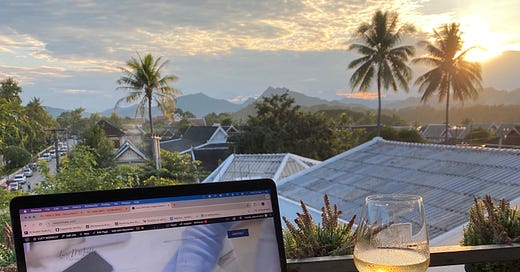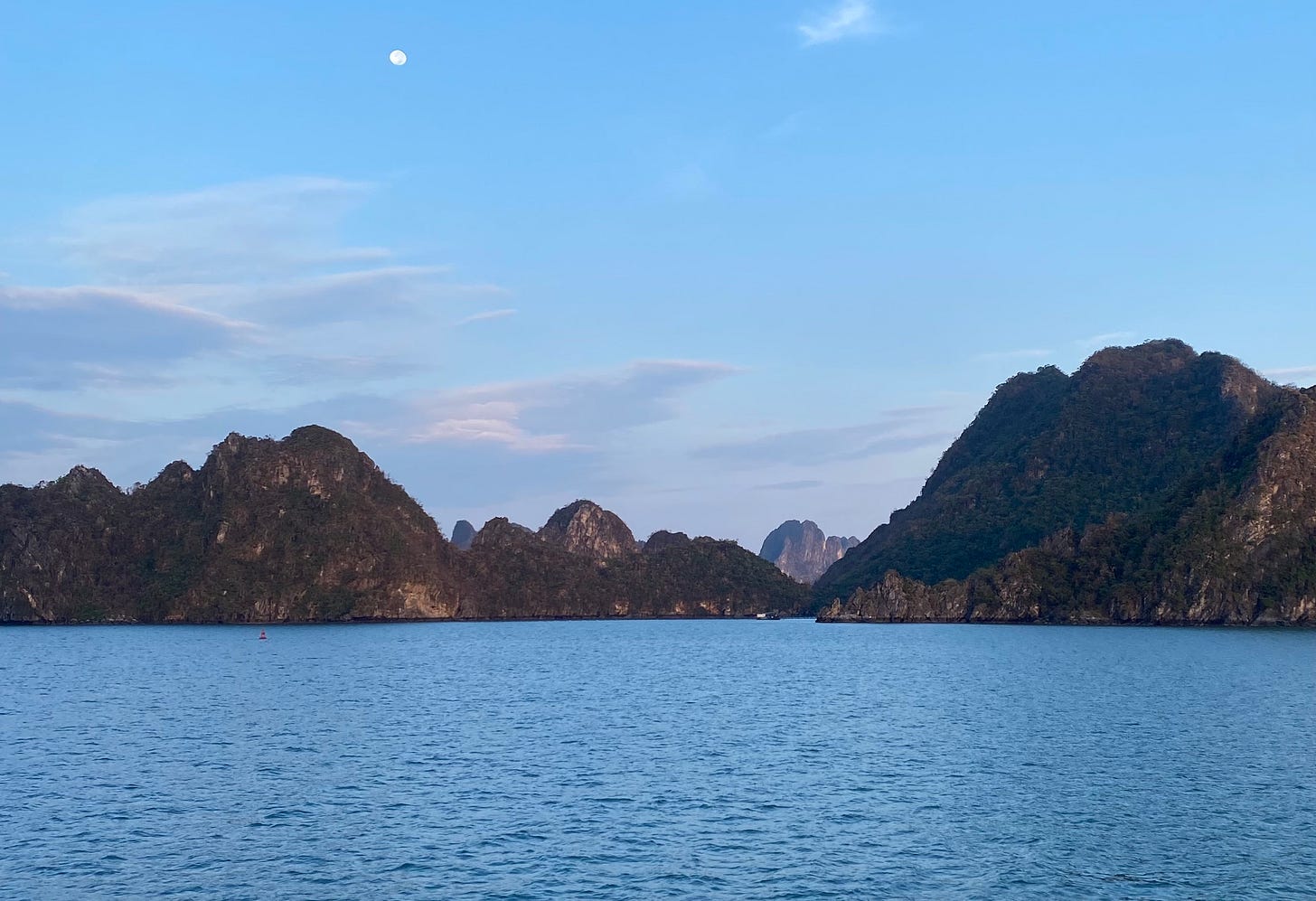Work From Anywhere: Coworking in Southeast Asia
Back in September, I flew out to Southeast Asia for three weeks to experience life like a true digital nomad. Here’s how I got on.
When I think back to a few months ago when we were having a crappy rain-filled summer, I was filled with excitement about jetting off to Southeast Asia in the autumn. I had planned to visit several regional hotspots, places that I’d saved Instagram clips of over the last few years: Hanoi and Ha Long Bay in Vietnam, Vientiane and Luang Prabang in Laos, and Chiang Mai in Thailand. I was then meeting a friend in Kuala Lumpur before meeting family in Bali for a few days followed by a couple of days in Singapore.
All the while, I planned to experience remote work like a true digital nomad! Here’s how I got on.
Disconnected in Ha Long Bay
I flew into Hanoi, the capital of Vietnam in mid-September. Turns out it was peak typhoon season – the country was hit by the largest typhoon in 75 years on the day I was originally due to land. I pushed my trip back by a week to finish up a few projects at home shortly after moving house so thankfully missed it, although was sad to see the damage it caused.
After spending a few days wandering around the sites of Hanoi’s historic Old Quarter, enjoying street food, and browsing artisan products, I booked a one-night boat cruise in Ha Long Bay. Little did I know that the boat was without WIFI the entire time due to the typhoon damaging a phone mast in the area. We were disconnected for an entire 24 hours – probably the first time this has happened to me in years. It actually turned out to be a really pleasant way to experience the sublime landscape around us, sans distractions. I spoke to pretty much everyone in the group, and I think the lack of connectivity made everyone super friendly, which made for a fantastic couple of days doing activities like visiting the archipelagos, walking through caves, a tai chi lesson, and a cooking class.
Back on shore, we were taken to the cruise company hotel to wait for a transfer back to the city. I plugged back in and got a few hours of work done. Throughout my trip, I ensured that every place I stayed in had fast WIFI and a communal area with comfortable seating where I could achieve some work.
Top tip: Knowing when you’ll have internet access means you can plan work and communication with clients accordingly. It’s great to have that balance – do make time to switch off while you’re travelling!
Staying safe in Southeast Asia
It’s surprising how many people worried about me going to Southeast Asia alone, especially visiting Laos. I’m much more self-aware now than when I was a 22-year-old fresh out of university back in 2017, when I moved to Phnom Penh to pursue a job in property. I used to jump on the back of motorbikes and all sorts (looking back, I wouldn’t recommend it)!
This time, I was much more considerate about my modes of travel and places to stay. Even so, I booked a dodgy hotel in Vientiane which I checked out of only 10 minutes after arriving! The capital of Laos was definitely not what I expected and I’d say that’s down to following advice in Lonely Planet, which I’d say wasn’t tailored to my tastes when I got there. I’d add that the writers were male and their recommendations generally just didn’t appeal to me personally.
Top tip: Always keep a bag around your front or in your eyesight as unfortunately, pickpocketing is common in Southeast Asia. Never hold your phone out where a motorbike driver can grab it when driving past. I have always felt safe when travelling alone in the region, but it’s worth staying aware of situations around you.
Coworking in Laos
The ancient city of Luang Prabang was one of my favourite visits. It’s a stunning mountainous town with old temples and palaces. There were several social enterprises to visit, including Ock Pop Tok (meaning “East meets West” in Lao) – a living craft centre with stunning riverside views – and the Traditional Arts and Ethnology Centre (TAEC) – which had a fantastic exhibition on cultural appropriation in the global fashion industry.
I booked a guesthouse with an epic rooftop bar but felt I needed to have a proper workspace for a day (and air conditioning). To find it, I googled ‘coworking in Luang Prabang’ and the first suggestion was a website for The Desk – the only coworking space in Luang Prabang, nestled amongst the heritage buildings.
There, I met founder Chris – a German expat who launched The Desk after his ambition to cycle the world got caught short during the pandemic. He was stranded in Vietnam, and couldn’t find anywhere to stay, so he cycled to Laos before settling in Luang Prabang. A few months later, Chris felt there needed to be a place where residents and travellers could connect (and get their work done too). The Desk comprises a hot desk area on the ground floor, with a couple of large tables for collaborative coworking, and phone booths, and a more permanent members area upstairs. I find it fascinating to think that coworking spaces weren’t a thing in Luang Prabang four years ago!
Like many coworking and coliving spaces in seasonal locations, The Desk operates to demand. Reaching out in advance in the low season (September-December) guarantees that Chris will open the space for you. Otherwise, you might find it shut when you turn up! This approach also meant I was connected with Chris before arriving, and his friendly communication helped me feel settled.
Top tip: Trying out a coworking space for a day is a great way of connecting with locals and residents. If I had to go back to when I was living in Cambodia, this is exactly how I would go about meeting new people. Book ahead in low season (September – December) to guarantee an opening.
Chiang Mai: A nomad haven
My final solo travel destination was Chiang Mai in Thailand – a nomad haven. I originally planned to stay in a coliving space called The Social Club, which came with free workspace, however, when I cut down my trip it meant I didn’t have enough time to stay as the minimum stay was five nights. Instead, I stayed at a hotel with a lovely pool, where I worked for a few hours on my final morning, before moving into their cafe when a storm rolled in (the nature of travelling during the rainy season)!
In Chiang Mai, ‘cafe culture’ is all the rage — a great way to get out and enjoy the town rather than staying cooped up in a hotel room or even a hotel lobby. Low season meant that the hotels were quiet. Like in the UK, the etiquette of coworking in a cafe requires buying a coffee or some food. However, coworking spaces in Southeast Asia are cheap and can provide more reliable internet and a comfortable temperature, as well as a safe place to leave your belongings if you pop out to visit some sites.
Chiang Mai is the second most popular spot for digital nomads, after Bali. I flew out to Bali the following week to holiday with my family so I only worked in the villa, but the cafes were teeming with people and despite the rest of the region being quiet, Bali was absolutely heaving.
I also didn’t work much in Singapore — it was a flying trip right before I got back, although the WIFI in the airport was brilliant, as expected. When I’ve previously gone out to Singapore, I’ve visited a couple of WeWorks there, and there are several coworking hubs located in high-rises.
Top tip: Although Bali is a beautiful place, it was heavily congested with tourists and was quite expensive, as was Singapore. I felt that the vibe and cost in Chiang Mai and Luang Prabang were much more tailored to nomads on a budget, and provided lots of coworking options.
Cambodia pre-pandemic
This time, I didn’t go to Cambodia as I lived out there between 2017 and 2019. But this blog post wouldn’t be complete without touching on my previous experiences. Back in 2017, I was a fresh Art History graduate who probably hadn’t even heard of coworking before! Like Chiang Mai, there were lots of cafes dotted around the Cambodian capital, where I’d worked from with friends as many of us worked flexibly. My favourites were in the heritage houses.
Impact Hub was Phnom Penh’s only coworking space before Factory opened in 2018, a sprawling campus located out of an old Levi’s factory, transformed into a social space for good complete with art galleries, skate and trampoline parks, and a coworking space – Workspace1 – by day. By night, it hosted workshops and networking sessions, pop-up craft, and farmer markets at weekends, and I’ll never forget the opening party!
Factory is such a destination that it’s mentioned in Lonely Planet, and Coworkies’ Around the World in 250 Coworking Spaces — this book became a bit of a Bible when I was planning my travels, I’d highly recommend using it to plan your travels to get acquainted with global coworking spaces.
Working from anywhere
What was my main lesson from my travels? As long as I can find a solid internet connection and a decent coffee, I could pretty much work from anywhere. Whether I was working from my hotel in the middle of a storm in Hanoi to sitting out by the pool in Chiang Mai, the world was literally my oyster. Of course, there are a few exceptions – the boat trip being one example, and if I were to travel more of Vietnam, I worried that the mountainous region of Sapa might have been a bit disconnected. But generally, if there’s a town with cafes and third places around, like being back home, it is easy to find a place to achieve some work.
Now I’m back home and moved slightly further out of the city, I’ve taken a hiatus from my coworking space membership, opting for more ad-hoc options in cafes near my gym and free workspaces with friends. I have a proper office setup in my spare room, having multiple screens is quite a luxury after spending three weeks with just a laptop! I thoroughly enjoyed my travels, but I’m glad to be back home, with lots of funny stories to share.







